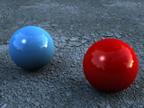|
|
 |
|
finalRender 101: Basic HDRI and Ray Tracing Added on: Sun Apr 28 2002 |
| Page: 1 2 3 |

But what GI test render would be complete without chrome or a teapot?

I resisted the urge to include a teapot, but placed a chamfer box behind the spheres. To make a decent chrome start with an FR material with a Blinn shader.
Under the Blinn Basic Paramenters set the ambient and diffuse colors to black, and the specular to white, or near white. Under the Final Render Parameters rollout set the filters for both reflections and refractions to white. Change the Reflection Level to 100 and render.
In my next tutorial I'll address Subsurface Light Scattering and the Texture Baker. |
|
|



